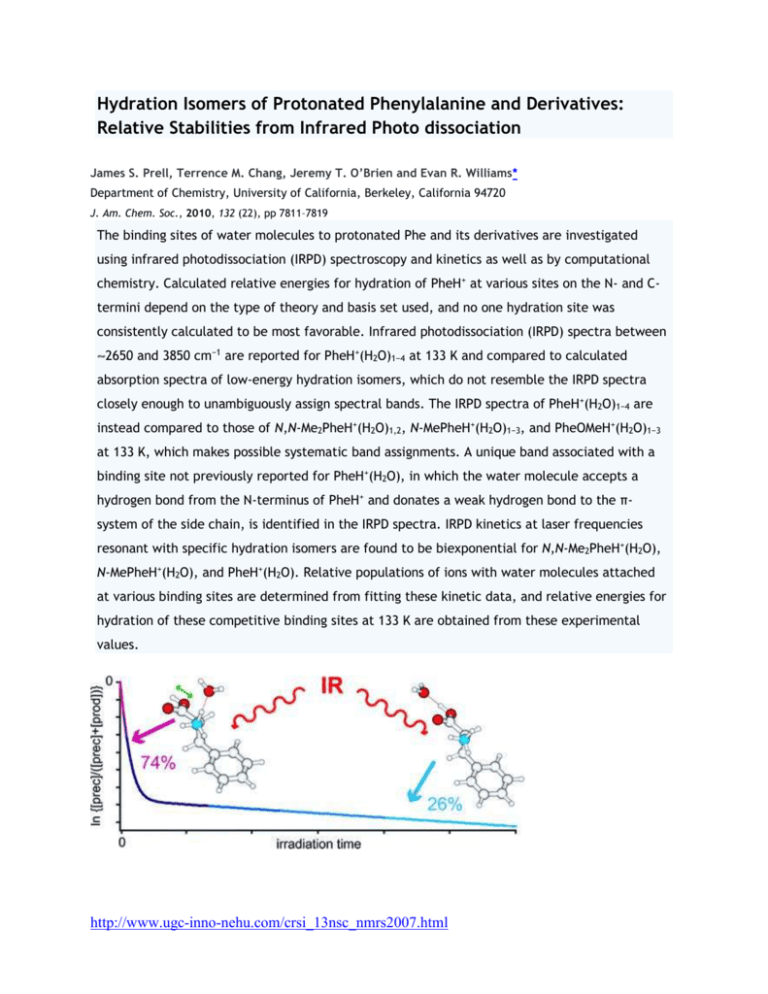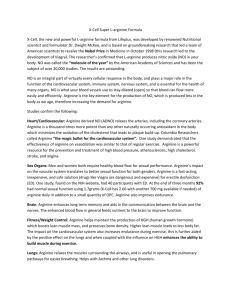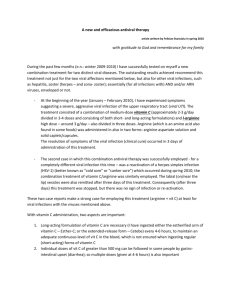Sheetf_19_20_21_22
advertisement

Hydration Isomers of Protonated Phenylalanine and Derivatives: Relative Stabilities from Infrared Photo dissociation James S. Prell, Terrence M. Chang, Jeremy T. O’Brien and Evan R. Williams* Department of Chemistry, University of California, Berkeley, California 94720 J. Am. Chem. Soc., 2010, 132 (22), pp 7811–7819 The binding sites of water molecules to protonated Phe and its derivatives are investigated using infrared photodissociation (IRPD) spectroscopy and kinetics as well as by computational chemistry. Calculated relative energies for hydration of PheH+ at various sites on the N- and Ctermini depend on the type of theory and basis set used, and no one hydration site was consistently calculated to be most favorable. Infrared photodissociation (IRPD) spectra between 2650 and 3850 cm−1 are reported for PheH+(H2O)1−4 at 133 K and compared to calculated absorption spectra of low-energy hydration isomers, which do not resemble the IRPD spectra closely enough to unambiguously assign spectral bands. The IRPD spectra of PheH+(H2O)1−4 are instead compared to those of N,N-Me2PheH+(H2O)1,2, N-MePheH+(H2O)1−3, and PheOMeH+(H2O)1−3 at 133 K, which makes possible systematic band assignments. A unique band associated with a binding site not previously reported for PheH+(H2O), in which the water molecule accepts a hydrogen bond from the N-terminus of PheH+ and donates a weak hydrogen bond to the πsystem of the side chain, is identified in the IRPD spectra. IRPD kinetics at laser frequencies resonant with specific hydration isomers are found to be biexponential for N,N-Me2PheH+(H2O), N-MePheH+(H2O), and PheH+(H2O). Relative populations of ions with water molecules attached at various binding sites are determined from fitting these kinetic data, and relative energies for hydration of these competitive binding sites at 133 K are obtained from these experimental values. http://www.ugc-inno-nehu.com/crsi_13nsc_nmrs2007.html One Water Molecule Stabilizes the Cationized Arginine Zwitterion Matthew F. Bush, James S. Prell, Richard J. Saykally, and Evan R. Williams* Contribution from the Department of Chemistry, University of California, Berkeley, California 94720-1460 J. Am. Chem. Soc., 2007, 129 (44), pp 13544–13553 DOI: 10.1021/ja073796b Publication Date (Web): October 11, 2007 Copyright © 2007 American Chemical Society Singly hydrated clusters of lithiated arginine, sodiated arginine, and lithiated arginine methyl ester are investigated using infrared action spectroscopy and computational chemistry. Whereas unsolvated lithiated arginine is nonzwitterionic, these results provide compelling evidence that attachment of a single water molecule to this ion makes the zwitterionic form of arginine, in which the side chain is protonated, more stable. The experimental spectra of lithiated and sodiated arginine with one water molecule are very similar and contain spectral signatures for protonated side chains, whereas those of lithiated arginine and singly hydrated lithiated arginine methyl ester are different and contain spectral signatures for neutral side chains. Calculations at the B3LYP/6-31++G** level of theory indicate that solvating lithiated arginine with a single water molecule preferentially stabilizes the zwitterionic forms of this ion by 25−32 kJ/mol and two essentially isoenergetic zwitterionic structure are most stable. In these structures, the metal ion either coordinates with the N-terminal amino group and an oxygen atom of the carboxylate group (NO coordinated) or with both oxygen atoms of the carboxylate group (OO coordinated). In contrast, the OO-coordinated zwitterionic structure of sodiated arginine, both with and without a water molecule, is clearly lowest in energy for both ions. Hydration of the metal ion in these clusters weakens the interactions between the metal ion and the amino acid, whereas hydrogenbond strengths are largely unaffected. Thus, hydration preferentially stabilizes the zwitterionic structures, all of which contain strong hydrogen bonds. Metal ion size strongly affects the relative propensity for these ions to form NO or OO coordinated structures and results in different zwitterionic structures for lithiated and sodiated arginine clusters containing one water molecule. http://www.ugc-inno-nehu.com/crsi_13nsc_nmrs2007.html Free Carboxylate Stretching Modes Jos Oomens* and Jeffrey D. Steill FOM Institute for Plasma Physics “Rijnhuizen, 3439MN Nieuwegein, The Netherlands J. Phys. Chem. A, 2008, 112 (15), pp 3281–3283 DOI: 10.1021/jp801806e Publication Date (Web): March 26, 2008 Copyright © 2008 American Chemical Society We report the first IR spectroscopic observation of carboxylate stretching modes in free space, i.e., in the complete absence of solvent or counterions. Gas-phase spectra of a series of benzoate anions have been recorded and compared to condensed-phase spectra, revealing the profound influence of the environment on the symmetric and antisymmetric carboxylate stretch modes. A Consistent Force Field for the Carboxylate Group Maxim Tafipolsky and Rochus Schmid Journal of Chemical Theory and Computation2009 5 (10), 2822-2834 Action Spectroscopy of Gas-Phase Carboxylate Anions by Multiple Photon IR Electron Detachment/Attachment Jeffrey D. Steill and Jos Oomens The Journal of Physical Chemistry A2009 113 (17), 4941-4946 http://www.ugc-inno-nehu.com/crsi_13nsc_nmrs2007.html Theoretical Investigation of the Neutral/Zwitterionic Equilibrium of γAminobutyric Acid (GABA) Conformers in Aqueous Solution Michael Ramek*† and Peter I. Nagy*‡ Institut für Physikalische und Theoretische Chemie, Technische Universität Graz, A-8010 Graz, Austria, and Department of Medicinal and Biological Chemistry, The University of Toledo, Toledo, Ohio 43606-3390 J. Phys. Chem. A, 2000, 104 (29), pp 6844–6854 DOI: 10.1021/jp000628w Publication Date (Web): July 1, 2000 Copyright © 2000 American Chemical Society Since γ-aminobutyric acid does not form a stable zwitterionic species in the gas phase, as calculated at the HF/6-311++G** level, the GABA·2H2O system was optimized for several neutral and zwitterionic GABA tautomers/conformers. The obtained molecular geometries and vibrational frequencies determined for the dihydrates reflect structural changes for GABA due to close and strongly bound water molecules. By use of GABA geometries optimized in the dihydrates, relative free energies of different species in aqueous solution were calculated. MP2/6-311++G**//HF/6-311++G** energy values show that the neutral form is strongly preferred over the zwitterionic one for the isolated GABA species. The neutral tautomer, which is most stable in the gas phase, is only marginally changed by hydration; it is without an intramolecular hydrogen bond and has nearly gauche−gauche arrangements, 54 and −83°, for the NCCC and the CCCC torsion angles, respectively, as determined in the dihydrate. In aqueous solution the zwitterionic structure is dominant. Comparison of cyclic gauche−gauche forms and a partially extended, gauche−trans structure indicates the preference of the more extended form. This structure differs from the trans−gauche zwitterionic conformer found for GABA by X-ray experiments in the crystalline phase. The experimental GABA conformer is not stable either in the isolated form or in the gas-phase dihydrate. It is, however, more stable by about 6.5 kcal/mol than the gas-phase gauche−trans form, as turned out in a restricted geometry optimization. Such a large internal stabilization may allow the existence (even preference) of the experimental zwitterionic GABA structure in aqueous solution if solvent effects are preferable. Partition of GABA between water and chloroform is not favored. At least 7.5 kcal/mol free energy increase is required if the zwitterion either directly or after transformation to a neutral form would leave the aqueous phase and enter chloroform. This result supports the experimental finding that GABA does not cross the blood−brain barrier. http://www.ugc-inno-nehu.com/crsi_13nsc_nmrs2007.html





